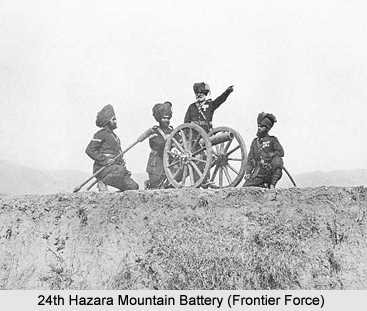 The 24th Hazara Mountain Battery (Frontier Force) was an artillery battery unit that functioned under the British Indian Army. The regiment was raised by British East India Company at Haripur in the year 1851. The primary objective of the army unit was to guard the Hazara district on the North West Frontier. The artillery regiment was incorporated as a part Punjab Army until 1895. It also served under the administrative authority of the Punjab Command. The military battalion served till the partition of India in 1947.
The 24th Hazara Mountain Battery (Frontier Force) was an artillery battery unit that functioned under the British Indian Army. The regiment was raised by British East India Company at Haripur in the year 1851. The primary objective of the army unit was to guard the Hazara district on the North West Frontier. The artillery regiment was incorporated as a part Punjab Army until 1895. It also served under the administrative authority of the Punjab Command. The military battalion served till the partition of India in 1947.
Military Operations of 24th Hazara Mountain Battery (Frontier Force)
The 24th Hazara Mountain Battery (Frontier Force) took part in a number of minor British operations on the North West Frontier. The troops participated in the Second Afghan War in 1878. The artillery battery regiment fought at the Battle of Ali Masjid and also served in the Siege of the Sherpur Cantonment. Later in 1885 it provided military service in the Second Burmese War.
The troops were again stationed on the Frontier in 1895 and were made a part of the Chitral Expedition. In 1905 the troops participated in the Rawalpindi Parade that was held to celebrate the Indian visit of the Prince and Princess of Wales. The regiment was sent to East Africa during the outbreak of the First World War. It was posted in there until the ceasefire. The 24th Hazara Mountain Battery later took part in the Third Afghan War in 1919; the Afridi and Red Shirt Rebellion from 1930 to 1931; the Mohmand and Bajaur Operations in 1933; and in the military operations during the Waziristan campaign from the year 1936 to 1939.
During the commencement of the Second World War the battalion was posted in Singapore. It was eventually captured by the Japanese forces along with the rest of the military post.
This article is a stub. You may enrich it by adding more information to it. You can send your write-up at content@indianetzone.com



















